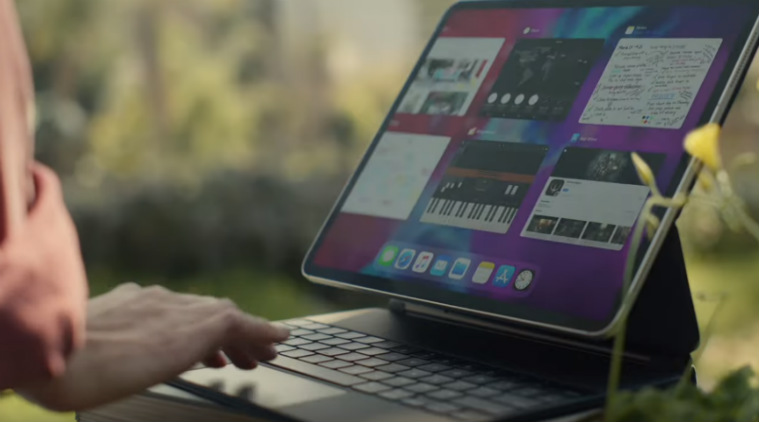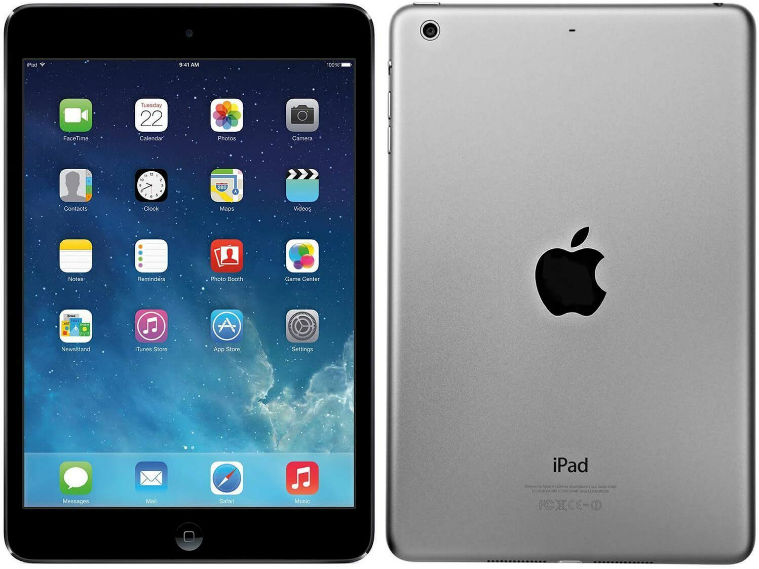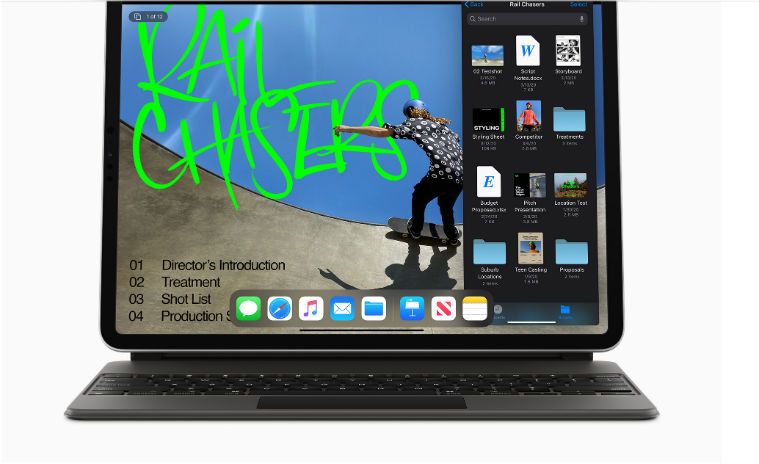When Did the Ipad First Have a Back Camera
 Apple's new iPad is more closer to your personal computer, thanks to a host of implements made over the past few years.
Apple's new iPad is more closer to your personal computer, thanks to a host of implements made over the past few years.
On January 27, 2010, Steve Jobs took the stage at a special Apple event and took out a tablet out of an envelope, this was the first Apple iPad. Designed by the team of Jony Ive, the iPad was a giant step in creating "a third category of device, something between a laptop and a smartphone." However, skeptics criticised Apple… some even called the iPad a big iPod Touch, others predicted it would fail miserably. But Apple proved the entire industry and the critics wrong.
Fast forward to 2020, and with each newer generation the iPad has got an upgrade and gained new features and capabilities. While the first iPad was more or less seen as a media consumption tablet, the newer models are as good as regular laptops in terms of features and performance.
Apple has, in fact, taken a new direction with the iPad. With iPadOS, the iPad is on the path to becoming your primary computer. With the launch of the new iPad Pro, it's time to look back at the evolution of the iPad.
iPad (1st generation)
Announced: Jan 27, 2010
Available: April 3. 2010
Key features: 9.7-inch 1024x768p display; 1GHz A4 chip; 10-hour battery
Price: $499
The original iPad has a special place in the tech world. Being the first iPad, there are a lot of fond memories attached to it. Launched on April 3, 2010, the original iPad was a big slab of glass that was made for browsing the web, playing games, reading eBooks and watching videos. It featured the same user interface and operating system as the iPod Touch and iPhone, including the 3-axis accelerometer that enables the tablet to detect when it is being moved or tilted. Approximately 300,000 iPads were sold on Day 1, according to Apple.
 For the first time, Apple brought the FaceTime application on the iPad, allowing users to make video calls with other iPhone/iPod Touch users. (Image credit: Amazon.com)
For the first time, Apple brought the FaceTime application on the iPad, allowing users to make video calls with other iPhone/iPod Touch users. (Image credit: Amazon.com)
iPad 2 (2nd generation)
Announced: March 2, 2011
Available: March 11, 2011
Key features: Thinner and lighter; improved performance; camera for video recording
Price: $499
The iPad 2 was a major improvement over the original iPad. It featured the dual-core Apple A5 processor, which brought significant processing capability. It also included a more powerful graphics processor. The iPad 2 was also thinner and lighter than the original iPad. Most importantly, the iPad 2 got front and back cameras for video recording. For the first time, Apple brought the FaceTime application on the iPad, allowing users to make video calls with other iPhone/iPod Touch users. The iPad 2 also came with an optical smart cover.
iPad (3rd generation)
Announced: March 7, 2012
Available: March 16, 2012
Key features: 4G support; Retina display
Price: $499
The third-generation iPad came with the Retina Display, making the highest resolution display for a tablet at the time of launch. It featured the same processor as the iPad 2 with better graphics. Although the iPad 3 was thicker and slightly heavier than its predecessor, the device was surely an improvement on many fronts. For instance, iPad 3 became the first iPad to feature 4G connectivity. It also got a 5MP camera.
Express Tech is now on Telegram. Click here to join our channel (@expresstechnology) and stay updated with the latest tech news
iPad Mini (1st generation)
Announced: October 23, 2012
Available: November 2, 2012
Key features: Compact and lighter than the regular iPad;4G capability
Price: $329
For the first time ever, Apple introduced a mini version of the iPad. The 7.9-inch iPad was a slimmed-down version of the iPad but offered the same features as the regular iPad, including dual-facing cameras and 4G support. Although Apple never made a distinction between the regular iPad and iPad Mini, the latter proved to be more popular among ladies and kids, thanks to better portability and small screen size. At $329, the iPad Mini was the cheapest iPad in Apple's iPad lineup.
iPad (4th generation)
Announced: October 23, 2012
Available: November 5, 2012
Key features: A better processor; 4G support; 128GB storage option
Price: $499
The iPad 4 wasn't a significant update over the iPad 3. It offered the same features as the iPad, including a Retina Display and 4G support but came with a more powerful A6 processor and up to 128GB of internal storage.
iPad Mini (2nd generation)
Announced: October 22, 2013
Available: November 12, 2013
Key features: Retina display; A7 processor
Price: $399
With the original iPad Mini, many found the tablet underpowered. With the iPad Mini 2, Apple tried to address those concerns by adding a Retina Display and an A7 processor. But these features increased the cost of the iPad Mini 2. Unlike the iPad Mini which was sold for $329, the new iPad Mini started at $399 for the base model.
 The iPad Air was the first iPad to feature a 64-bit processor. (Image credit: Amazon.com)
The iPad Air was the first iPad to feature a 64-bit processor. (Image credit: Amazon.com)
iPad Air
Announced: October 22, 2013
Available: November 1, 2013
Key features: Thinner and lighter; A7 processor
Price: $499
The iPad Air was way better than any previous-generation iPad. Not only was it twice as powerful as its predecessor, but the tablet was also lighter and slimmer as well. The iPad Air was the first iPad to feature a 64-bit processor. Not many remember this, but the iPad Air was the first to feature dual microphones that offered noise cancellation for better audio while recording videos.
iPad Mini (3rd generation)
Announced: October 16, 2014
Available: October 22, 2014
Key features: Touch ID fingerprint sensor; Apple Pay
Price: $399
The iPad Mini 3 offered the Touch ID fingerprint sensor and Apple Pay for the first time. However, the iPad Mini didn't offer any performance boost over the previous model. The tablet featured the A7 chip and the Retina Display. It was an underwhelming upgrade over the iPad Mini 2.
iPad Air 2
Announced: October 16, 2014
Available: October 22, 2014
Key features: Thin and light; improved screen;
Price: $499
The iPad Air 2 was a lot different from any previous-generation iPad. While it retained the design language from the iPad Air, but it was a lot slimmer and lighter. The tablet had a very powerful processor (A8X, to be precise), and was the first iPad multi-carrier SIM connection. The iPad Air 2 shipped with iOS 9, which introduced split-screen.
iPad Pro (1st generation)
Announced: September 9, 2015
Available: November 11, 2015
Key features: 12.9-inch screen; Apple Pencil support
Price: $799
With the iPad Pro, Apple took the first step to break the image of the iPad as a consumption-only device. The 12.9-inch iPad Pro was a giant tablet, dwarfing the 9.7-inch iPad Air 2. But the size wasn't the highlight of the iPad Pro. It featured the A9X processor, and Apple talked up the iPad Pro's fast performance. The 12.9-inch Pro was also the first iPad to support Apple Pencil and the Smart Keyboard. The iPad Pro had four stereo speakers, more than any other iPad.
iPad Mini 4
Announced: September 9, 2015
Available: September 9, 2015
Key features: Improved cameras; A8 chipset
Price: $399
The iPad Mini 4 was introduced alongside the iPad Pro in 2015. The new version of the iPad Mini had the same features as the iPad Air 2, including all the multitasking features. The Mini 4 also featured a redesigned chassis that was thinner, lighter and slightly taller. Unfortunately, the iPad Mini 4 was completely overshadowed by the iPad Pro during Apple's launch event.
9.7-inch iPad Pro
Announced: March 21, 2016
Available: March 24, 2016
Key features: True Tone display; 12MP camera
Price: $599
The 9.7-inch iPad Pro was more aligned to Apple's goal of making the iPad a laptop replacement. The 9.7-inch iPad Pro featured many of the same features as the 12.9-inch iPad Pro, including the A9X chipset, four stereo speakers, Apple Pencil support, and Smart keyboard. It also came with a new 12MP camera for shooting Live Photos and 4K video.
iPad (5th generation)
Announced: March 21, 2017
Available: March 27, 2017
Key features: Affordable price tag
Price: $329
While Apple continued to push the Pro lineup at the high-end, the company didn't forget to update the entry-level iPad. The iPad (5th generation) was Apple's least expensive full-size iPad with a big enough screen, the capable processor inside and 10 hours of battery life. The fifth-generation iPad was targeted at schools.
 The new iPad Pro was the first iPad to support HDR video, (Image credit: Apple.com)
The new iPad Pro was the first iPad to support HDR video, (Image credit: Apple.com)
iPad Pro (2nd generation)
Announced: June 5, 2017
Available: Mid-June, 2017
Key features: 120Hz display;
Price: $649/$799
The second-generation iPad Pro, available in 12.9-inch and 10.5-inch screen sizes, was more close to replacing the laptop. The new iPad Pro was the first iPad to support HDR video, a feature typically reserved for high-end TVs. It also featured a True Tone Display that adjusts its brightness and tone depending on your environment. Its AX10x processor offered faster performance and improved graphics performance, making it adequate to run high-performance games and apps. It also supported Apple's Smart Keyboard accessory and the Apple Pencil.
The iPad Pro shipped with iOS 11, which included many new features such as file browser for searching for files, a dock at the bottom that allows you to keep more icons on the screen at once, drag and drop features, multi-tasking with multi-windows and more.
iPad (6th generation)
Announced: March 27, 2018
Available: March 27, 2018
Key features: Apple Pencil support; A10 processor
Price: $329
The entry-level 9.7-inch iPad finally gained the ability to use Apple Pencil, which was earlier limited to the iPad Pro. Plus, the sixth-generation iPad also featured the A10 processor. Thanks to the Apple Pencil support, the iPad (6th generation) was aimed at students or anyone who wants to use the iPad for work and pleasure.
iPad Pro (3rd generation)
Announced: October 30, 2018
Available: November 7, 2018
Key features: A12X processor; New design; Liquid Retina Display; FaceID
Price: 11-inch, $799/12.9-inch, $999
Launched at Apple's special event in the fall of 2018, the iPad Pro (3rd generation) was designed for professional users. Made available in 11-inch and 12.9-inch options, the iPad Pro looked different from other iPad, featuring thin bezels and a sleeker, cleaner look.
Inside, the iPad Pro featured a more powerful A12X Bionic chipset that was great for multitasking and running apps like Adobe Photoshop. It was also the first iPad to feature FaceID and a USB Type-C port. The iPad Pro also came with the second-generation Apple Pencil. When launched, the third-generation iPad Pro was the most expensive iPad on the market.
iPad Mini (5th generation)
Announced: March 18, 2019
Available: March 25, 2019
Key features: Apple Pencil support; A12 processor
Price: $399
There's an interest in the iPad Mini, and the iPad Mini (5th generation) is a proof. Last year, Apple updated the iPad Mini with a new processor and Apple Pencil support. It has a 7.9-inch screen, an A12 Bionic chipset and 64GB of internal storage. The new Mini also offers first-generation Apple Pencil support. The biggest advantage of buying the iPad Mini is that it's portable and handy to carry, plus the Mini doesn't cost too much.
iPad Air (3rd generation)
Announced: March 18, 2019
Available: March 25, 2019
Key features: Apple Pencil support; Smart Keyboard
Price: $499
The new iPad Air was launched in 2019 and it's the third-generation of the device. The new iPad Air features a 10.5-inch Retina display and a more powerful A12 Bionic processor. The tablet is affordable at $499 and also comes with Apple Smart Keyboard and the first-generation Apple Pencil.
iPad (7th generation)
Announced: September 10, 2019
Available: September 30, 2019
Key features: A10 processor; Apple Pencil support; Apple Keyboard
Price: $329
The new iPad (7th generation) now sports a 10.2-inch Retina display, upgraded cameras, longer battery life, Apple Pencil support and the company's Smart Keyboard. Apple pitches the new iPad for both work and leisure. Although it's an entry-level device, the new iPad has got many of the same features that are found on the iPad Air (2019). The iPad ships with iPadOS. With Apple Pencil and Keyboard support, Apple is pushing the entry-level iPad as a replacement for cheap windows laptops and Chromebooks in many US schools.
 The iPad Pro 2020 comes with an optional Magic Keyboard that features backlit keys and a trackpad.
The iPad Pro 2020 comes with an optional Magic Keyboard that features backlit keys and a trackpad.
iPad Pro (4th generation)
Announced: March 18, 2020
Available: March 24, 2020
Key features: 3D scanner, Ultrawide camera
Price: 11-inch, $799, 12.9-inch, $999
The new iPad Pro is Apple's latest attempt to replace your existing Windows laptop. The iPad Pro may look identical to the previous iPad Pro model but a lot has been changed. It features an eight-core A12Z Bionic chip, a 10MP ultra-wide camera sensor, a 12MP standard camera, and a lidar sensor on the back of the device that will enable users to measure the distance to surrounding objects, making it easier to measure objects. The refresh includes a new Magic Keyboard with backlit keys, a trackpad similar to what is found on laptops. and a hinge that allows users to move the iPad freely.
When Did the Ipad First Have a Back Camera
Source: https://indianexpress.com/article/technology/mobile-tabs/apple-ipads-evolution-through-the-years-from-being-a-tablet-to-a-computer-6321888/
0 Response to "When Did the Ipad First Have a Back Camera"
Post a Comment